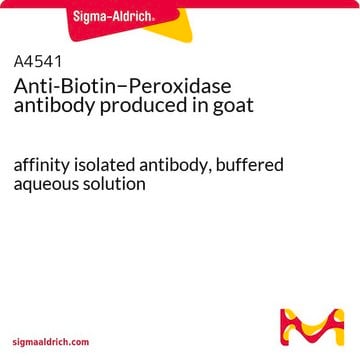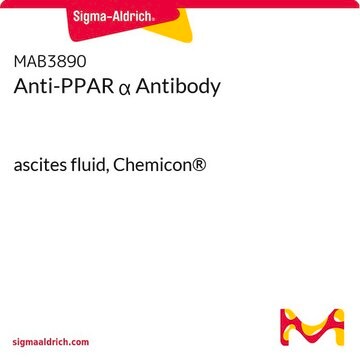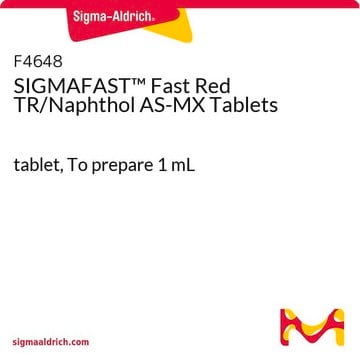11426346910
Roche
Anti-Fluorescein-POD, Fab fragments
from sheep
Synonym(s):
antibody
Sign Into View Organizational & Contract Pricing
All Photos(1)
About This Item
UNSPSC Code:
12352203
Recommended Products
biological source
sheep
Quality Level
conjugate
peroxidase conjugate
antibody form
purified immunoglobulin
antibody product type
primary antibodies
clone
polyclonal
form
lyophilized (stabilized)
packaging
pkg of 150 U
manufacturer/tradename
Roche
storage temp.
2-8°C
General description
Fab fragments from polyclonal anti-fluorescein antibodies, conjugated to horseradish peroxidase. The reagent is an anti-fluorescein antibody, Fab fragments from sheep, conjugated with horse-radishperoxidase (POD). After immunization with fluorescein the sheep IgG (immunoglobulin G) was purified by ion exchange chromatography and the specific IgG was isolated by immunosorption. The Fab fragments obtained by papain digestion were purified by gel filtration, conjugated with POD and stabilized in 60mM Tris-Hepes-buffer, 0.4% bovine immunoglobulin (w/v), 0.2% Germall II (w/v), pH 7.2.
Specificity
The polyclonal antibody reacts with free and bound fluorescein.
Application
Anti-Fluorescein-POD, Fab fragments are used for detection of fluorescein-labeled compounds in:
- Dot blot
- ELISA (enzyme-linked immunosorbent assay)
- Immunohistocytochemistry
- In situ hybridization
- Southern blot
- Western blot
Preparation Note
Working concentration: Working concentration of conjugate depends on application and substrate. The following concentrations should be taken as a guideline:
Working solution: 100 mM Tris-HCl, 150 mM NaCl, pH 7.5. If necessary 1% Blocking reagent (w/v), dry milk powder, 1 to 5% heat inactivated fetal calf serum (v/v) or sheep normal serum can be used for reduction of unspecific binding.
- Dot blot: 150 mU/ml
- ELISA: 50 to 150 mU/ml
- Immunohistocytochemistry: 250 to 500 mU/ml
- In situ hybridization: 1.5 to 7.5 U/ml
- Southern blot: 150 mU/ml
- Western blot: 500 to 1000 mU/ml
Working solution: 100 mM Tris-HCl, 150 mM NaCl, pH 7.5. If necessary 1% Blocking reagent (w/v), dry milk powder, 1 to 5% heat inactivated fetal calf serum (v/v) or sheep normal serum can be used for reduction of unspecific binding.
Reconstitution
Add 1 ml double-distilled water to a final concentration of 150 U/ml.
Other Notes
For life science research only. Not for use in diagnostic procedures.
Not finding the right product?
Try our Product Selector Tool.
Signal Word
Warning
Hazard Statements
Precautionary Statements
Hazard Classifications
Skin Sens. 1
Storage Class Code
12 - Non Combustible Liquids
WGK
WGK 1
Flash Point(F)
does not flash
Flash Point(C)
does not flash
Certificates of Analysis (COA)
Search for Certificates of Analysis (COA) by entering the products Lot/Batch Number. Lot and Batch Numbers can be found on a product’s label following the words ‘Lot’ or ‘Batch’.
Already Own This Product?
Find documentation for the products that you have recently purchased in the Document Library.
Customers Also Viewed
Alemji A Taku et al.
Development (Cambridge, England), 143(1), 123-132 (2016-01-07)
Olfactory sensory axons target well-defined intermediate targets in the zebrafish olfactory bulb called protoglomeruli well before they form odorant receptor-specific glomeruli. A subset of olfactory sensory neurons are labeled by expression of the or111-7:IRES:GAL4 transgene whose axons terminate in the
Iku Tsutsui-Kimura et al.
Nature communications, 8, 14304-14304 (2017-02-02)
Impaired motivation is present in a variety of neurological disorders, suggesting that decreased motivation is caused by broad dysfunction of the nervous system across a variety of circuits. Based on evidence that impaired motivation is a major symptom in the
Lisa A Thomas et al.
The Journal of comparative neurology, 510(1), 47-67 (2008-07-11)
Cell-cell interactions through adhesion molecules play key roles in the development of the nervous system. Synaptic cell adhesion molecules (SynCAMs) comprise a group of four immunoglobulin (Ig) superfamily members that mediate adhesion and are prominently expressed in the brain. Although
Johannes Kohl et al.
Nature, 556(7701), 326-331 (2018-04-13)
Parenting is essential for the survival and wellbeing of mammalian offspring. However, we lack a circuit-level understanding of how distinct components of this behaviour are coordinated. Here we investigate how galanin-expressing neurons in the medial preoptic area (MPOAGal) of the
Guozhu Ning et al.
Developmental cell, 24(3), 283-295 (2013-02-16)
Craniofacial malformations are common structural birth defects and usually associate with abnormal development of pharyngeal arches. Although some microRNAs have been found to be implicated in chondrogenesis in vitro, few have been shown to be essential for cartilage and bone development
Our team of scientists has experience in all areas of research including Life Science, Material Science, Chemical Synthesis, Chromatography, Analytical and many others.
Contact Technical Service







